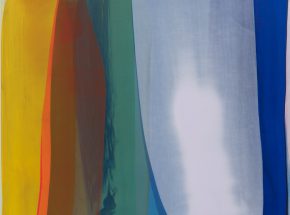

Known as the pioneer of the dot (long before Damien Hirst), Thomas Downing’s compositions use simple circles to elevate color, making it the sole subject and object in his works. Downing cites Helen Frankenthaler and Morris Louis’ works as major influences to his own.
Downing was born in Suffolk, Virginia in 1928, and graduated from Randolph-Macon College, later attending the Pratt Institute in New York (1949-50), where he became acquainted with many of the first generation Abstract Expressionist painters. He then traveled to Europe on a grant from MOFA, studying briefly at the Academie Julian in Paris before returning to the United States. He served in the army, then moved back to teach and paint in Washington D. C. in 1954. There he met Kenneth Noland, one of the founding fathers of the Washington Color School of Painting, who became a friend and major influence on Downing’s work. Noland had been a student of Josef Albers, and both Downing and Noland had a shared attraction to Albers’ color theory and formalism. In 1959, he co-founded Origo, a cooperative gallery in D.C. alongside his studio-mate, Howard Mehring, and Betty Pajac.
In many of Downing’s most iconic dot pieces he works off of raw canvas, which he said, “kept light and air in the color no matter how dense or intense”. Through his masterful color compositions, each piece has an implied depth that alludes to deeper space, without clearly defining it.
In 1964, in the seminal “Post-Painterly Abstraction” exhibition at LACMA, Clement Greenberg included Downing’s work. Subsequently, his paintings were featured in “The Washington Color Painters” exhibition, curated by Gerald Nordland at the Washington Gallery of Modern Art in 1965. These exhibitions were Downing’s official consecration in the original group of first generation Washington Color School artists.
“The expressive capacities of pure color, divorced from natural form or from Cubist derivations, have been explored with clarity and precision and the resultant expansive, buoyant, and lyrical paintings have inspired still another generation.” — Gerald Norland, on Downing’s work
